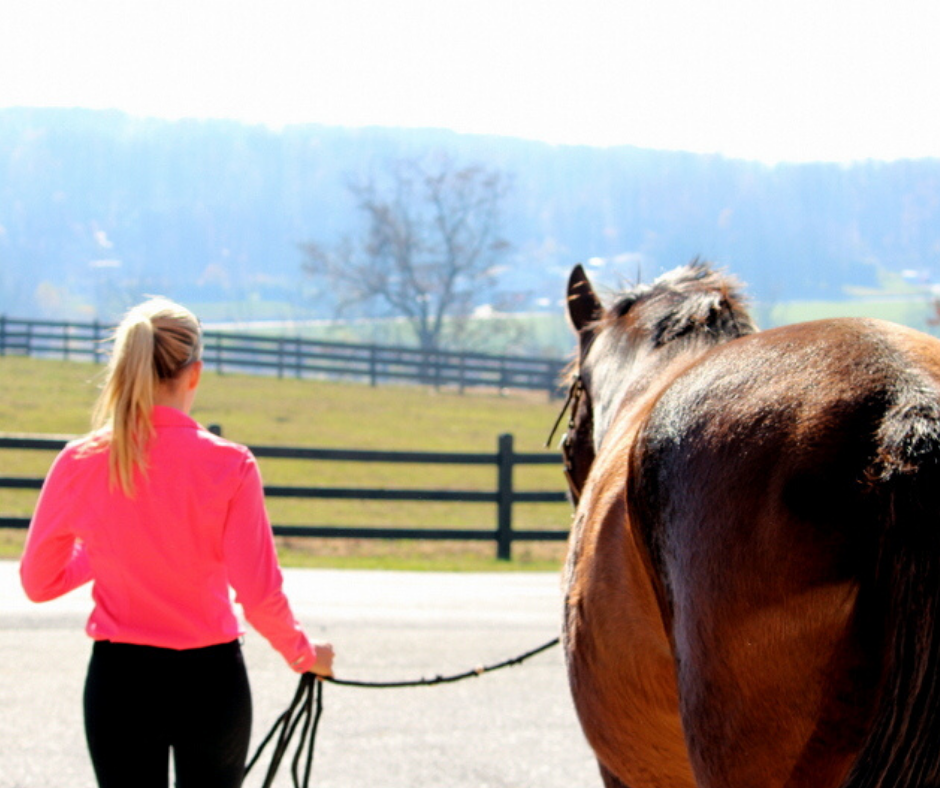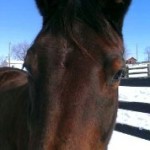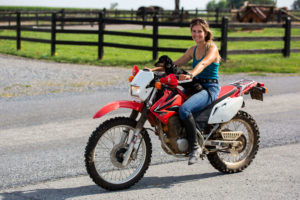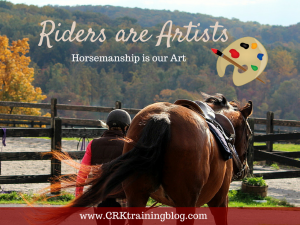What makes a safe horse? Is it bombproofing techniques – working to desensitize them to as much as possible?
Is it the horse that is quiet and still, seemingly unflappable in any situation?

Are we assured to stay safe as long as we are going slow, riding in an arena, or with a good instructor?
In this article, I want to talk about accepting risk, what creates safety, and the illusions we can all be fooled by.
If we choose to climb onto the back of a horse, we are taking a risk. There is real physical danger being off the ground by 5 feet or more, and balancing on the back of a moving animal with a mind and emotions of its own.
By deciding we want to ride we need to acknowledge that risk.
Of course some activities will increase risk. Logically, steeplechasing is more dangerous than walking around an arena.
But there is one factor that is the most important in safety, and not only does it matter for our safety, but I believe it is the biggest factor in what makes a horse safe as well.
When we first think of safety in riding, we think of the horse. What type of horse is the most quiet and safe? What kind of training will make them more predictable, less reactive, more trustworthy, etc?
The factors that influence personality are complex – a mix of genetics, life experience, and environment. This is as true for horses as for humans.
Some horses will naturally be more sensitive, more athletic, quicker in their movements, and tend to bigger swings in emotion.

A horse’s tendencies are only one factor, however, as reading their current state is more important. We often look at a horse that is being still, perhaps appearing sleepy and oblivious to the world around him as being quiet and calm. The term “bombproof” is used to describe these horses, alluding that a bomb could go off and the horse would not react.
But a still horse is not always a calm horse. When stress gets too high, and escape is not an option, the horse can retreat inward, checking out from the external environment. If the horse is in this kind of situation repeatedly, this inward retreat becomes habit, and the horse may go there with even minimal stress.
Dozing off is normal and occasionally going into this inward state is also normal, but understanding how checking out can be a reaction to stress helps us recognize that what we see on the outside of the horse is not always what is going on in their inner world.

A safe horse is one who is aware of the world around him and actively engaging in it. A safe horse is one who does not check out from frightening external stimulus, but notices it, and either becomes curious or clearly displays his trepidation. From this point, he can make a choice to investigate, move past, or decide that whatever he noticed was not a threat.
It is the awareness and the processing that we want from the horse. This is part of what makes a horse safe because we can more easily recognize their emotional state and when they are actively engaged in the world around them, sudden startles or big “out of the blue” reactions are much less likely to occur.
A horse who is present will be engaged. Even if sleeping, when prompted they can look at what is around them, fully taking in their surroundings and remaining calm.
To learn more about recognizing the difference between being still and stressed or being calm and connected, read this excellent article from Natural Lifemanship.
Exercises designed to desensitize a horse can encourage this awareness, teaching the horse to be curious about the world around him, showing the horse that he can have control of the world around him, and that his emotional state is recognized and responded to by the person with him.
On the other hand, if desensitizing is done in a way that is overwhelming to the horse, where their only strategy is to tune it all out, then the opposite of awareness and curiosity is taught.
The success of desensitizing varies depending on whether the process teaches the horse to check out from the world around them or whether it teaches them to be aware of their world, curious, interactive, and thinking.
We, as the human, the rider, the handler, also have a responsibility to stay aware. We also need to be considering all the aspects of our environment to know the risk we are choosing.
First, we need to be aware of ourselves. Are we feeling anxious, distracted, calm, tired? We need to notice when our internal state changes and pause to ask why. What did our senses pick up or where did our thoughts go to cause that change?
Giving control of ourselves over to a coach, instructor, or trainer is not responsible. No other individual can know how we feel and how much risk we are willing to take.

Improving skills means pushing against or outside the edges of one’s comfort zone, but some people are willing to take a big jump outside their comfort zone and accept the extra risk in doing so. Others are not, and prefer to just brush up against the edges. The risk you are willing to assume, and how much you want to push yourself is your individual decision.
Next, we need to be aware of our horse, to really see what their state is, to notice when it changes.
This awareness of both ourselves and another creates connection. In connection, there is presence and attunement. The horse is aware of their environment, and of the person, and the person is aware of both as well.
So what does create safety? Safety comes from full awareness, beginning with acknowledging risk and being conscious in how much risk one is willing to assume. Awareness extends to being connected to how one feels and connected to the world and the others surrounding. This is as true for our horses as it is for us as humans.














16 Responses
Hi, thanks a lot, this is so true. My horse teaches me all that during storming, or better: silent times. It has had a hard time, and it retreaded inward, as you said. It wasn’t my fault, somebody (whom I don’t know, I guess it was beaten very strong, it has had strange marks in his winter-coat) had treated it very bad, it became depressed, no more playing with other horses, no fun meeting with me (and my carrots). I listened always to her, but then she don’t talked anymore. I routinely “worked” with her, she responded, until one day she has had a panick attack.
I searched for help, found Imke Spilker (Empowerded horses). Before my horse went silent, many people had asked me, if I was a I. Sp.-pupil. But I didn’t know her before my horse went ill. And after reading the book (and met I. Sp.) I listened even more to my horse, gave her room, asked for a while nothing from her. Now she is the Safe Horse, that she was before her depression. She loves children, and you could put any child on her back, she would never ever shy at anything. And she talks to me, her depressive silence is over. I always listen – and because I listen, I can give in in her suggestions, or give other suggestions, and she gives in. Because it’s now a give and a take, and she ist so safe with, like she was when she was only 7 months old (and came to me until she was mistreted). Hope my English is ok 🙂
Hi
I think anyone horse shopping should read this article! I was seriously injured by a new horse that I did not realize had learned to internalize when he was faced with something he was afraid of or did not understand. He checked out. I misunderstood that for calmness. Unfortunately he had been broke by an aggressive heavy-handed rider and placed up for sale. A fact I did not know, In a new environment the horse bolted unexpectedly, I came off and had multiple fractures. He continued to bolt unexpectedly with my trainer and I gave the horse to a professional who restarted him. A sound, very attractive horse, he continued to bolt over fences and remained an unsatisfactory and not entirely safe mount. I lost $30K, months of riding and learned a painful lesson.
Couldn’t agree more Carolyn – every prospective owner should read this before making a purchase!
-Julia Burdy, CRK Training Community Manager
I’m pretty much a beginner but I’ve noticed how much my horse (and others) are influenced by the state of mind of the rider. If I’m nervous she will be; if I’m calm it’s much more likely that she will be too. And it’s also very easy to get into a negative spiral – if I’m a bit nervous, she gets flighty, I get more nervous. ..
Hi and thank you for that. I read the article in the link about ways to know your horse is disassociating rather than cooperating. It is interesting but I’m a bit confused about the licking and chewing part, as it is known to be a sign of relaxation. I do understand that excessive or exaggerated chewing is related to stress. But usually when a horse is stressed at the beginning of the work, then start licking it’s a sign of relaxation. Of course there will be other signs too. Can you explain?
Hi Tamar, we actually did a video on the blog about this, you can click here to watch and learn more about the subtle signs of stress in horses.
-Julia Burdy, CRK Training Community Manager
In consideration of this subject, I instantly recall all the old movie Westerns I have watched over the decades. Nowadays I simply “rent” a horse from a stable/farm to go trail riding. Thus I do not establish any strong personal relationship with any one horse (other that a couple I had lessons with). Recalling those movies I alluded to, I am frequently struck by how the “actor” horses display a total lack of reaction to a great deal of action going on around them, until someone leaps upon such a horse and gets it to do something (gallop away, turn aside, etc.). How do the trainers achieve such obedience? The trainers are never in the filmed scenes, but the horses fully display the reaction of “bombproof”. I realize that most of the handlers of those horses back then must have passed on, but there must be a few left around, and it might be helpful to get input from them. I’m thinking of the people involved with “The Horse Whisperer”, etc.
Ray, those horses are very used to being in those types of environments!
-Julia Burdy, CRK Training Community Manager
Hi,
I suddenly understand ab abnormal reaction from a school horse called Chestnut Charmer. He would generally look very calm, would never spook or go fast. In fact he would need to be whipped couple of times to even walk actively. But surprisingly one morning, he started walking right and left, started to buck when whipped and finally started bucking when I was using my leg to nudge him forward – ultimately I got off him because I got scared. I do not know how he his now though. But perhaps this behaviour on this particular day was a release of pent-up stress!
I’m glad this helped you better understand Chester Charmer Sathya!
-Julia Burdy, CRK Training Community Manager
Callie, very well written. I especially enjoyed you stating that “Giving control of ourselves over to a coach, instructor, or trainer is not responsible. No other individual can know how we feel and how much risk we are willing to take. ” I started riding with an instructor here in Spain after I bought a horse. My gelding is 8 years old, not a school horse and I am still a beginner English rider. I follow your videos and wanted to stop and collect myself after getting nervous while cantering. He kept telling me to keep going and I couldn’t stop. I am 43 years old and I wanted to stop and breathe. After a horrible fall almost 2 years ago, I am much more nervous. He started yelling and finally I just said “NO, I’m getting off.” I just wanted to say again how much I appreciate how much time you put into doing these blogs and videos to help others be better at all aspects of horsemanship. When I move back to the states I would love to attend one of your clinics!
Kimberly, good for you for sticking up for yourself! Thanks for your kind words about our videos, we would love to have you to the farm in the future!
-Julia Burdy, CRK Training Community Manager
This article is an eye-opener for me. When I take my horse out on a trail ride, he’s very alert, looking around all the time. This used to make me nervous, but I was told by a trainer that this type of horse is less likely to do a big spook, and indeed he’s only “spooked” once and that was a little “in place” spook – very small. This article reinforces what I was told earlier. Thanks!
Carol, yes! Great point, he is very observant of his environment it sounds like!
-Julia Burdy, CRK Training Community Manager
Great article, Callie. I ride an 11 year old mare who is very skittish whenever the barometer drops, winds blow and acorns etc. hit the arena’s metal roof. I find that if I get here to flex her jaw and soften at the bit, she relaxes a lot more. I don’t think this makes her “ignore” the “dangers”, just lets her deal with it better. Also, I have fallen off a couple times when she’d bolt/do a 180 when the wind rattles the roof or some other perceived danger. I realized that I was listening for every wind, acorn drop, etc. and this was making me tense. Since I started focusing more on whatever I am doing that day (ground poles, serpentines, circles, whatever), ignoring the wind/birds/acorns/icicles dropping, and feeling her hips under me, now my body flows with her when she bolts and I haven fallen off anymore!
This is so helpful! I’ve been nervous as my mare is very aware and engaged in her environment. She listens to me but is ever looking around and is a very curious girl. I need to foster that and not be afraid of it.
We’re at a new barn and she’s very nervous about everything, lots of new things for her to take in. She’s been a bit spooky in hand. I need to work more with her on curiosity. She loves checking things out but I think is a bit overwhelmed at the moment. It’s going to be very hot the next few days so I think groundwork will be good for us, exploring different areas of the farm. I love the set up so I feel pretty calm which I hope she’ll feel.